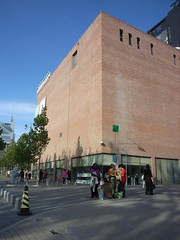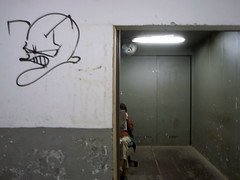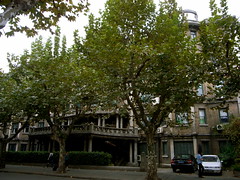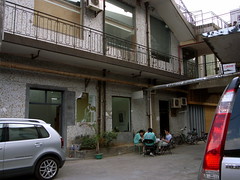
Shanghai Night - 不夜城
A friend looked at the Shanghai skyline, turned to me and said - "You know, every city now has one of these roof top bars."
Shanghai has always been a global city. Historically, with all the foreign concessions, it was akin to being colonised by multiple nations at one time. Its landscape reflects these influences - the assimilations and tensions, and its status today as an "expat" paradise merely continues that past.
It seems obvious that the art industry and centres of cultural influence are always built around centres of financial power - London, New York, and now, Shanghai+Beijing. Like most service industries, the art industry serves the powerful. As such, if you are thinking of starting an art business, the Chinese art industry offers these lessons:
(1) Land


Today Art Museum in Beijing; Installation at Zendai MOMA
If there's a Chinese Bill Gates and Donald Trump, it would be the latter who would be more likely to open and develop an art museum in China.
The museums of modern or contemporary art in China that I've visited all happened to be private and non-profit. Given the nature of contemporary art, it seemed natural that such museums are operated privately instead of by the state. But another thing these museums often have in common is their close relationship with real estate play. Both the Today Art Museum in Beijing and Zendai MOMA in Shanghai were started by real estate investment giants who collect and enjoy art.
While both non-profit institutions have different business models (I like Today's diversification into art publishing and archival/video documentation services), it is not by coincidence that both are located within new, large commercial or mixed-use developments by their founders' companies. In fact, the Zendai MOMA is gearing up to expand into its glass/steel cube "Zendai Himalaya Complex" nearby, named no doubt for its proportions. While the government has no direct stake in these developments, the promise of a hip contemporary art museum is not only a plus for property buyers/investors but may up the attractiveness of the land bid to the government.
(2) Location Location Location

lift to artist studios at M50
The development of art districts like 798 or the MoGanShan Road (or M50) art district have similar real estate impetus for the owners.
But for some galleries, their strategy is to get out from that competition and circus. And where your gallery is located says much.
ShanghArt's has expanded from its M50 location, and opened a branch on one of Shanghai's main shopping streets, in the compound of a beautifully restored and converted French residence along Huai Hai Rd together with some high-end fashion labels.

James Cohan Gallery
New York gallery James Cohan spent months searching instead for a 1930s building at Yue Yuan Rd in the quiet former French concession. The building seems an unlikely place for a gallery. It is still inhabited by other residents on the other levels, and shares a compound with another residential building with laundry in the balconies and garden. But walk into the Gallery and you will find beautifully restored stained glass, a lovely art deco stair case and terrazo floors, decorative Chinese ceilings and a garden with a stretch of scholar stones. Instead of focusing on contemporary Chinese artists, it is bringing major international artists like Bill Viola to China instead - hence its subtle location.


140sqm in the Black Stone
Former Beijing curator Yue located her new gallery 140sqm in a dark, rundown (by Singapore standards lah) 1920s building called "The Black Stone" a few streets away. Entering the building, you past a tiny room where a woman lies on a beach chair, walk up a narrow mosaic-tiled staircase bathed dimly in orange light, walk down a grey corridor before entering a sunlit apartment of art. Her focus is to discover new Chinese contemporary artists who maintain a strong artistic and intellectual integrity in their work. Asked if the location deters collectors, she says that the location often works to her advantage in attracting collectors curious about the space.
(3)

workers taking a break, backlane of M50
You can't get away from labour if you are running a business. Perhaps taking this to the extreme, Shanghai-based artist Zhou Tiehai openly declares that he has never actually painted anything and pays a team of 11 assistants to execute all his paintings. Conceptually, he is of course locating the art not in the product, but in the conception and the entire process. When asked if his work is then similar to that of a film director and script writer, he agrees but adds that for his latest dessert series, it is his friend, a French chef, who is the actual writer and co-director. When the follow-up question was asked about what then does he actually do, he smiled and said "My job is talking to you."

Zhou TieHai's Studio
Making art is labour-intensive, but in a capitalist context, the real value is reaped not by the workers but the guy who directs the workers and makes the sale. Your labour, as I found out from all the gallerists, is in the service extended to the customer - the talks given at museums, the interviews given to journalists, the hospitality extended to visitors, the advice handed to young collectors, the explanations and stories woven around art works (told perhaps over a cigar in your office), the liaison with shippers and pacifying of worried collectors...
In China, where labour and rental is cheap, you may not need lots of money to get a gallery going (NB. lesson obviously does not apply in Singapore!). But the relationships and trust nurtured with artists and collectors is not something that financial capital can secure. For a few, it is a labour of love.
====
Part 1 here
Comments
And yes, I like the Today art museum in Beijing. A lot of the art production and marketing in China is for/to foreigners, although there is a growing minority of rich Chinese "buying back" these works from the West. It creates an interesting dynamic; I think this consciousness of the international audience affects what the artists put out, and there is a general disconnect between them and Chinese society as a whole. It can work in their favour because there is more space and less scrutiny.
Zendai is opening a huge, fancy new place in 2010.